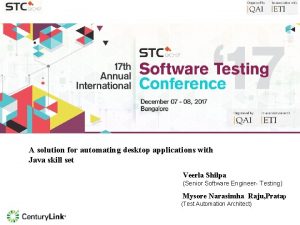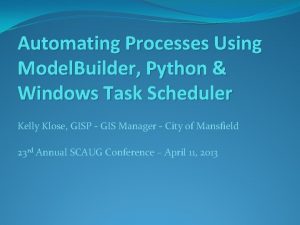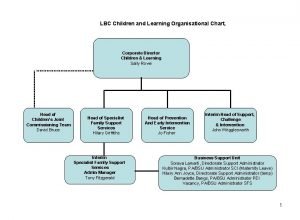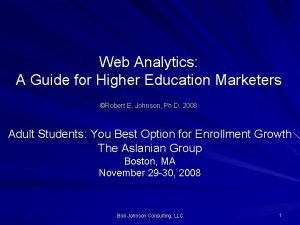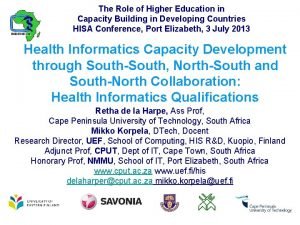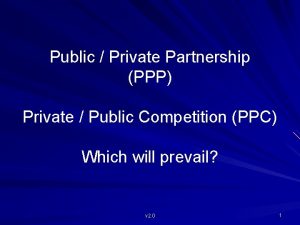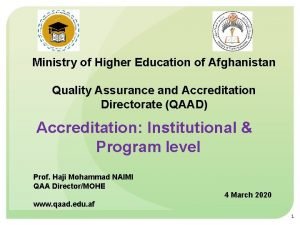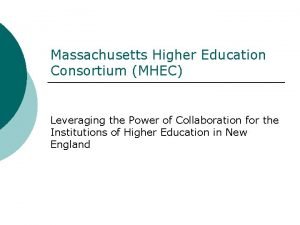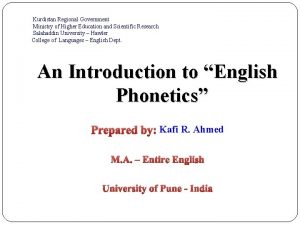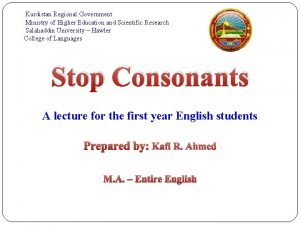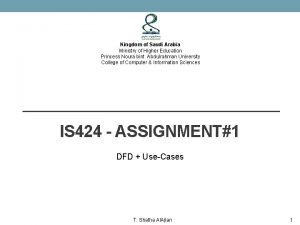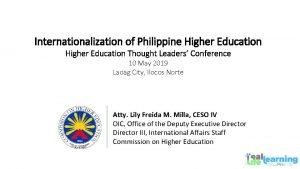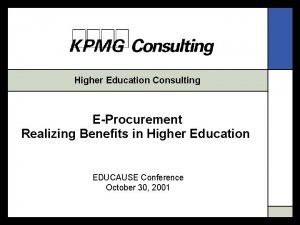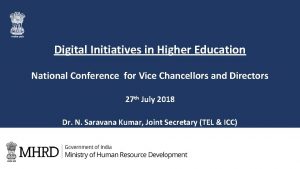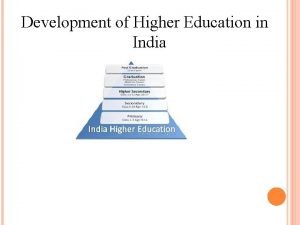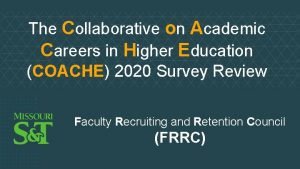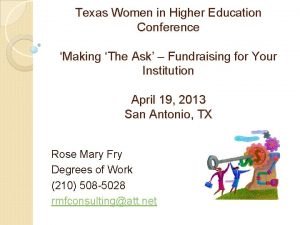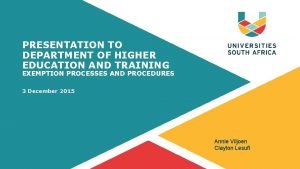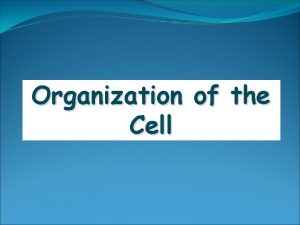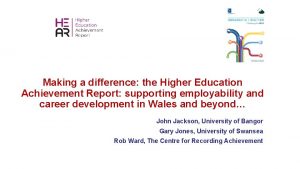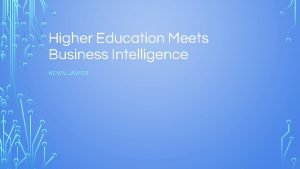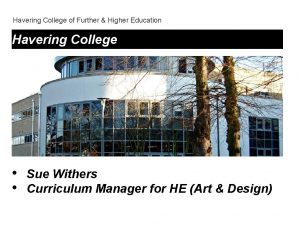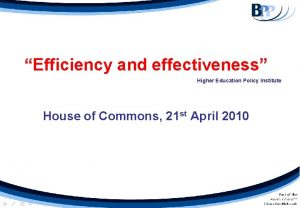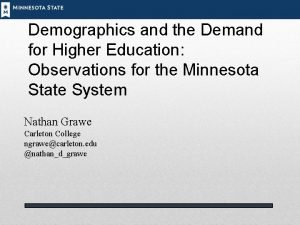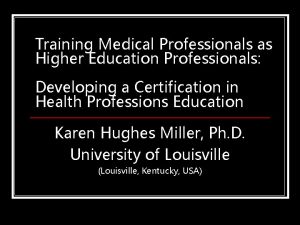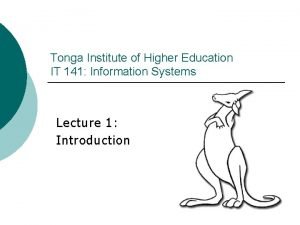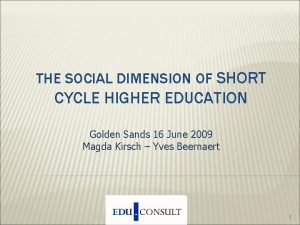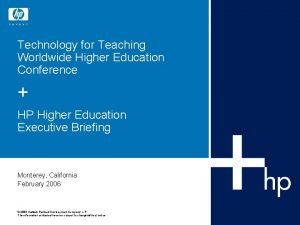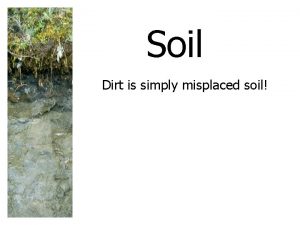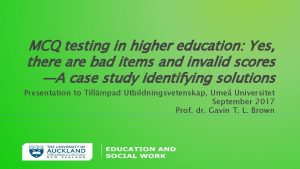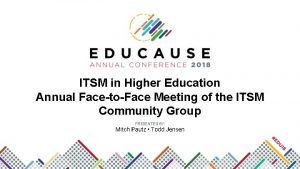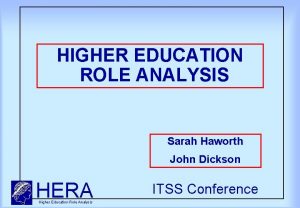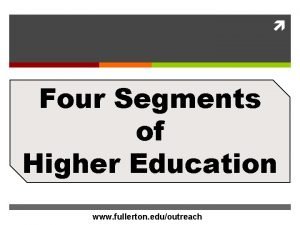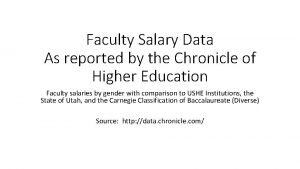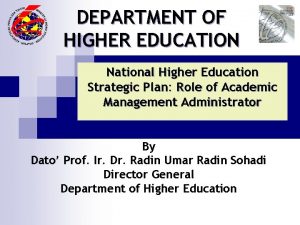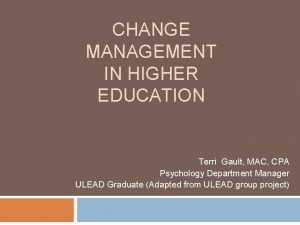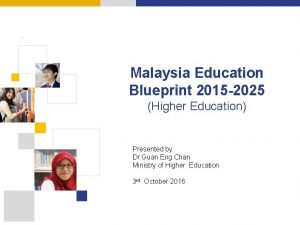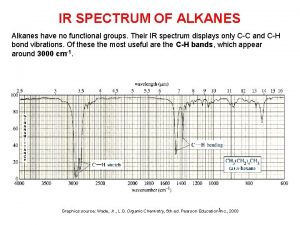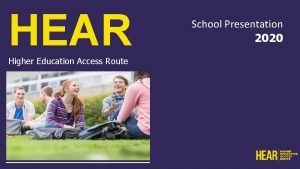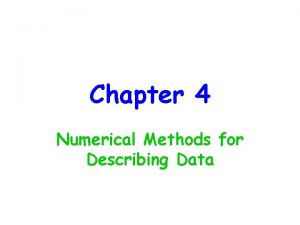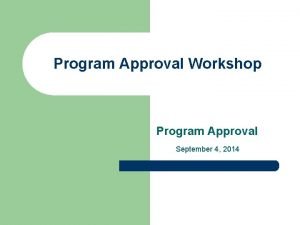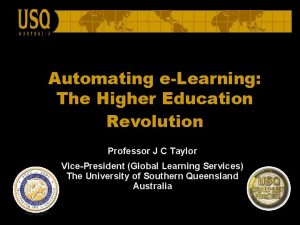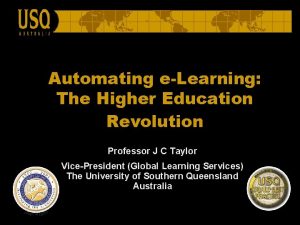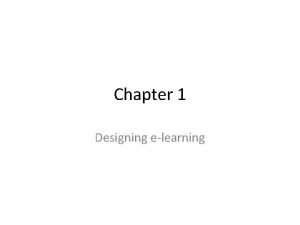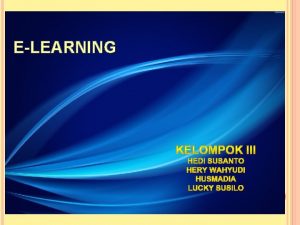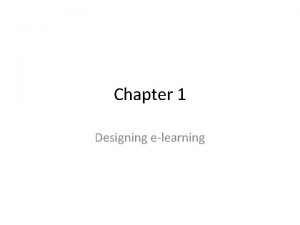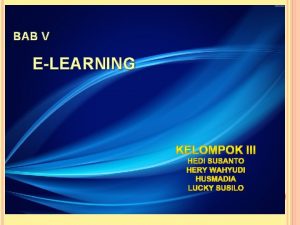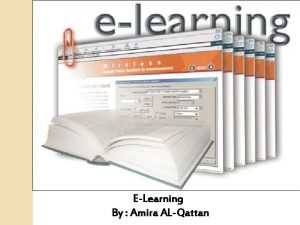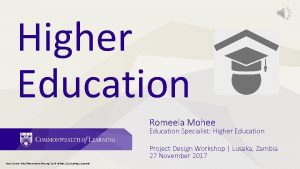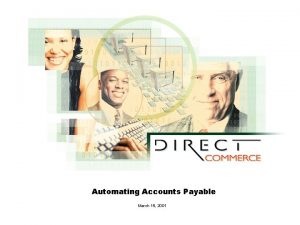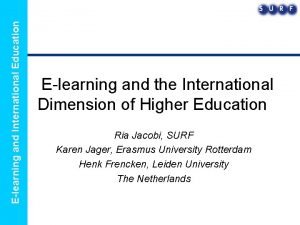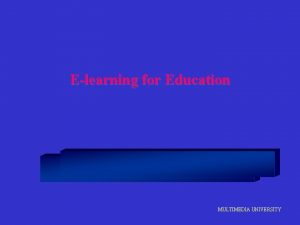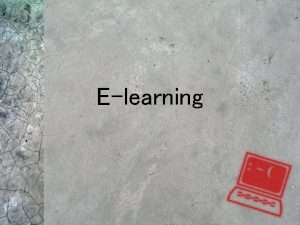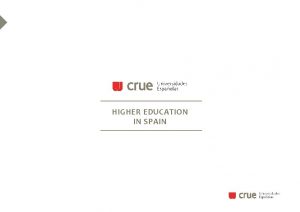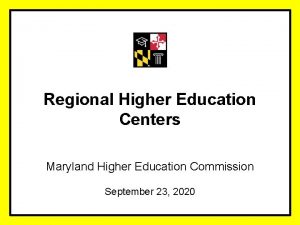Automating eLearning The Future of Higher Education Professor






















































- Slides: 54

Automating e-Learning: The Future of Higher Education Professor J C Taylor Vice-President (Global Learning Services) The University of Southern Queensland Australia

Joseph Schumpeter (1934) predicted that every 50 years or so, technological revolutions would cause "gales of creative destruction” in which old industries would be swept away and replaced by new ones.

Technological Changes § Steam Power - 1780 s to the 1840 s § The Railways - 1840 s to the 1890 s § Electric Power - 1890 s to the 1930 s § The Motor Car - 1930 s to the 1980 s § Information Technology - 1980 s to ?

Pace of Change 1. Radio: 50 million users in 38 years 2. Television: 50 million users in 13 years 3. The Internet: 50 million users in 5 years Current prediction: One billion users by the year 2003

Internet Access at Home % With Internet Access at Home § § § Australia 50% France 22% New Zealand 51% Sweden 61% UK 46% USA 60% Source: A C Nielsen, June 2000

e-Readiness Rankings: Leaders e-Readiness ranking 1 2 3 4 5 6 7 8 9 10 11 12 13 Country USA UK Canada Australia Norway Sweden Singapore Finland Denmark Netherlands Switzerland Germany Hong Kong e-Readiness score 8. 73 8. 10 8. 09 8. 29 8. 07 7. 98 7. 87 7. 83 7. 70 7. 69 7. 67 7. 51 7. 45 Source: The Economist Intelligence Unit e. Business Forum, May 2001

e-Readiness Rankings: Contenders e-Readiness ranking 14 15 16 (tie) 18 19 20 21 22 23 24 25 Country Ireland France Austria Taiwan Japan Belgium New Zealand South Korea Italy Israel Spain Portugal e-Readiness score 7. 28 7. 26 7. 22 7. 18 7. 10 7. 00 6. 97 6. 74 6. 71 6. 43 6. 21 Source: The Economist Intelligence Unit e. Business Forum, May 2001

e-Readiness Rankings: Followers e-Readiness ranking 26 27 28 29 30 31 32 33 34 35 36 Country Greece Czech Republic Hungary Chile Poland Argentina Slovakia Malaysia Mexico South Africa Brazil e-Readiness score 5. 85 5. 71 5. 49 5. 05 5. 01 4. 88 4. 83 4. 78 4. 74 4. 64 Source: The Economist Intelligence Unit e. Business Forum, May 2001

e-Readiness Rankings: Followers e-Readiness ranking 37 38 39 40 41 42 43 44 45 46 Country Turkey Colombia Philippines Egypt / Peru Russia Sri Lanka Saudi Arabia India Thailand Venezuela e-Readiness score 4. 51 4. 25 3. 98 3. 84 3. 82 3. 80 3. 79 3. 75 3. 62 Source: The Economist Intelligence Unit e. Business Forum, May 2001

e-Readiness Rankings: Laggards e-Readiness ranking 47 48 49 50 51 52 53 54 55 56 Country e-Readiness score Bulgaria China Ecuador / Iran Romania / Ukraine Algeria / Indonesia Nigeria Kazakhstan Vietnam Azerbaijan Pakistan 3. 38 3. 36 3. 30 3. 20 3. 16 2. 91 2. 76 2. 72 2. 66 Source: The Economist Intelligence Unit e. Business Forum, May 2001

The EIU E-Readiness Rankings A formula based on the following factors: § Connectivity (30%) § Business environment (20%) § E-Commerce consumer & business adoption (20%) § Legal & regulatory environment (15%) § Supporting e-Services (10%) § Social & cultural infrastructure (5%) Source: http: //www. ebusinessforum. com)

Prediction: 'The death of distance as a determinant of the cost of communications will probably be the single most important economic force shaping society in the first half of the 21 st century'. Cairncross (1997)

Underestimating Change § In the 1940 s the Chairman of IBM predicted that the world market for computers would be approximately five. § In 1977, the CEO of Digital could not comprehend why anyone should need a personal computer.

Getting it Wrong Western Union Internal Memo, 1876 “This telephone has too many shortcomings to be seriously considered as a means of communication. The device is inherently of no value to us”.

Education must lay the foundation for the success of the global economy.

Fast, Flexible and Fluid The transition from the Industrial to the Information Age was encapsulated by Dolence and Norris (1995), who argued that to survive organisations would need to change from rigid, formula driven entities to organisations that were “fast, flexible and fluid”.

Organisational Inertia Trying to change a university is like trying to move a graveyard --- it is extremely difficult and you don’t get much internal support.

Organisational Challenge Why should universities change? Increasing competition on a global scale.

Increasing Competition Unext (Business education only) § London School of Economics and Political Science § University of Chicago § Carnegie Mellon University § Columbia University § Stanford University

Increasing Competition The Cambridge e-MBA Cambridge University’s business school has joined forces with FT Knowledge, part of the global communications group Pearson plc, to offer this new degree from September 2001.

Fast, Flexible and Fluid? 791 years ago Cambridge University passed a rule requiring all students to reside in the town of Cambridge, England. Last year that rule was revoked. The 800 year-old rulebook had to be altered to make way for the university’s first Internet-enabled program, the global e-MBA.

Increasing Competition UCLA’s Online. Learning. net § offers more than 1, 000 online courses and has enrolled over 12, 000 students. § offers 1, 000 American Airlines frequent flyer points when you enrol in an online course.

Book publishing may again become a cottage industry: § Charles Dickens sold his novels, chapter by chapter, in his own magazine, “Household Words”. § Stephen King recently offered his new 16, 000 word ghost story, “Riding the Bullet”, for exclusive sale via the Internet at US$2. 50 per copy. § Readers were able to download the text onto their computers or e-books. § King sold 400, 000 copies during the first day.

The Big Picture § Change is the only constant. § Growth is the only certainty.

Future Projections § A recent IBM report forecasts a threefold (US$4. 5 trillion) jump in global education expenditure during the next 13 years. § The World Bank expects the number of higher education students will more than double from 70 million to 160 million by 2025. (Source: Richard Gluyas, New Nabs e-School Deal http: //finance. news. com. au, 22 April 2000).

The Global Lifelong Learning Economy Will USQ survive? Will your institution survive?

Enrolled Students USQ 2001 § All students § External § Percentage External 21, 063 15, 799* 75% *includes currently enrolled off-shore students 3, 981

USQ’s Off-Shore Students 2001 § § § § § Singapore Malaysia China South Africa Pacific Islands Zimbabwe United Arab Emirates Canada Total, including students from 60 other countries 1, 165 943 340 199 114 93 76 73 3, 981

Five Generations of Distance Education Technology § The Correspondence Model § The Multimedia Model § The Telelearning Model § The Flexible Learning Model § The Intelligent Flexible Learning Model

First Generation CHARACTERISTICS OF DELIVERY TECHNOLOGIESINSTITUTIONAL MODELS OF VARIABLE DISTANCE EDUCATION HIGHLY ADVANCED FLEXIBILITY COSTS AND ASSOCIATED REFINED INTERACTIVE APPROACHING ZERO DELIVERY TECHNOLOGIES Time Place Pace MATERIALS DELIVERY THE CORRESPONDENCE MODEL • Print Yes Yes No No

Second Generation CHARACTERISTICS OF DELIVERY TECHNOLOGIESINSTITUTIONAL MODELS OF VARIABLE DISTANCE EDUCATION HIGHLY ADVANCED FLEXIBILITY COSTS AND ASSOCIATED REFINED INTERACTIVE APPROACHING ZERO DELIVERY TECHNOLOGIES Time Place Pace MATERIALS DELIVERY THE MULTIMEDIA MODEL Yes Yes No No • Audiotape Yes Yes No No • Videotape Yes Yes No • Computer-based learning (eg CML/CAL) Yes Yes Yes No No • Interactive video Yes Yes Yes No • Print

Variable costs tend to increase or decrease directly (often linearly) with fluctuations in the volume of activity. In traditional distance education delivery, the distribution of packages of self-instructional materials (printed study guides, audiotapes, videotapes, etc) is a variable cost, which varies in direct proportion to the number of students enrolled.

Third Generation CHARACTERISTICS OF DELIVERY TECHNOLOGIESINSTITUTIONAL MODELS OF VARIABLE DISTANCE EDUCATION HIGHLY ADVANCED FLEXIBILITY COSTS AND ASSOCIATED REFINED INTERACTIVE APPROACHING ZERO DELIVERY TECHNOLOGIES Time Place Pace MATERIALS DELIVERY THE TELELEARNING MODEL • Audio-teleconferencing No No Yes No • Videoconferencing No No Yes • Audiographic communication No No No Yes No No • Broadcast TV/Radio and Audio-teleconferencing No No No Yes No

Fourth Generation CHARACTERISTICS OF DELIVERY TECHNOLOGIESINSTITUTIONAL MODELS OF VARIABLE DISTANCE EDUCATION HIGHLY ADVANCED FLEXIBILITY COSTS AND ASSOCIATED REFINED INTERACTIVEAPPROACHING ZERO DELIVERY TECHNOLOGIES Time Place Pace MATERIALS DELIVERY THE FLEXIBLE LEARNING MODEL • Interactive multimedia (IMM) Yes Yes Yes • Internet-based access to WWW resources Yes Yes Yes • Computer mediated communication (CMC). Yes Yes Yes No

Fifth Generation CHARACTERISTICS OF DELIVERY TECHNOLOGIESINSTITUTIONAL MODELS OF VARIABLE DISTANCE EDUCATION HIGHLY ADVANCED FLEXIBILITY COSTS AND ASSOCIATED REFINED INTERACTIVE APPROACHING ZERO DELIVERY TECHNOLOGIES Time Place Pace MATERIALS DELIVERY THE INTELLIGENT FLEXIBLE LEARNING MODEL • Interactive multimedia Yes Yes Yes • Internet-based access to WWW resources Yes Yes Yes • CMC, using automated response systems Yes Yes Yes • Campus portal access to institutional processes & resources Yes Yes Yes




XML (e. Xtensible Markup Language) RENDITIONS: Print STYLE SHEET: XSL Web CD DVD XSL XSL XML CONTENT REPOSITORY: INPUT: DTD (Document Type Definition) XML Editor



USQOnline demonstration…….

Garrison (1997) “The reflective and explicit nature of the written word is a disciplined and rigorous form of thinking and communicating …… it allows time for reflection and, thereby, facilitates learners making connections amongst ideas and constructing coherent knowledge structures”.

NO Incoming “new” question from student Search / Match Reusable Learning Objects Database Previous Questions <meta tags> Previous Answers <meta tags> New Answer YES “Immediate” feedback to student Trigger

th 5 Generation As the intelligent databases become more comprehensive, the institutional variable costs for the provision of effective student support will tend towards zero.








5 th Generation In effect, fifth generation distance provides students with better quality tuition and more effective pedagogical and administrative support services at lower cost.

The e-Revolution “Any new technology environment eventually creates a totally new human environment”. Marshall Mc. Luhan
 Exercise future continuous and future perfect
Exercise future continuous and future perfect Future perfect future continuous future perfect continuous
Future perfect future continuous future perfect continuous Promotion from assistant to associate professor
Promotion from assistant to associate professor Leanft vs selenium
Leanft vs selenium Pyautogui vs selenium
Pyautogui vs selenium Python windows desktop automation
Python windows desktop automation Joanne webb lbc
Joanne webb lbc Web analytics for higher education
Web analytics for higher education Capacity building in the field of higher education
Capacity building in the field of higher education Importance of faculty in higher education
Importance of faculty in higher education Rhode island board of governors for higher education
Rhode island board of governors for higher education Ppc for higher education
Ppc for higher education Ministry of higher education afghanistan
Ministry of higher education afghanistan Massachusetts higher education consortium
Massachusetts higher education consortium Ministry of higher education kurdistan
Ministry of higher education kurdistan Krg ministry of higher education
Krg ministry of higher education Krg ministry of higher education
Krg ministry of higher education Ministry of higher education saudi arabia
Ministry of higher education saudi arabia Internationalization of higher education in the philippines
Internationalization of higher education in the philippines Higher education eprocurement
Higher education eprocurement Digital initiatives in higher education
Digital initiatives in higher education Gartner digital transformation in higher education
Gartner digital transformation in higher education Wood despatch 1854
Wood despatch 1854 Who was the advocator of learning without burden
Who was the advocator of learning without burden Collaborative on academic careers in higher education
Collaborative on academic careers in higher education Texas women in higher education
Texas women in higher education Department of higher education and training
Department of higher education and training Mitochondria
Mitochondria Higher education achievement report
Higher education achievement report Education meets business
Education meets business Higher education access tracker
Higher education access tracker Havering college of further and higher education
Havering college of further and higher education Efficiency and effectiveness in higher education
Efficiency and effectiveness in higher education Demographics and the demand for higher education
Demographics and the demand for higher education Higher education mauritius
Higher education mauritius Training for higher education professionals
Training for higher education professionals Tonga institute of higher education
Tonga institute of higher education Short cycle higher education
Short cycle higher education Ohio department of higher education
Ohio department of higher education Hp higher education
Hp higher education Simply misplaced
Simply misplaced Mcq on higher education
Mcq on higher education Higher ed itsm
Higher ed itsm Higher education role analysis
Higher education role analysis Four segments of higher education
Four segments of higher education Chronicle salary data
Chronicle salary data National higher education strategic plan
National higher education strategic plan Change management in higher education
Change management in higher education Unit 5 higher education
Unit 5 higher education Malaysia education blueprint 2015 to 2025
Malaysia education blueprint 2015 to 2025 Ir spectrum of nitrile
Ir spectrum of nitrile Higher education access route
Higher education access route Chronicle of higher education
Chronicle of higher education Texas higher education coordinating board
Texas higher education coordinating board Texas higher education coordinating board
Texas higher education coordinating board



